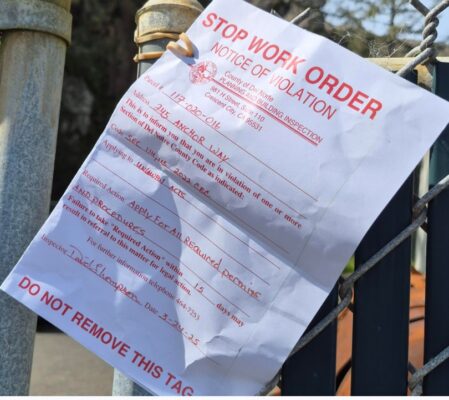By Investigative Reporter, Linda Sutter – March 25, 2025
In December 2024, a quiet inquiry about permits sparked a wave of revelations at our Crescent City Harbor District, located in Northern California. The focus was the Harbor House – a building that, for years had quietly functioned as an abalone farm/storage unit, but turned into staff housing. The justification? The crushing cost of rent in the local community. The reality? A potential firetrap, lacking legal permits, and at the center of a growing scandal
When a request was submitted to the county for permits related to the Harbor House’s residential use, the results were surprising: there were none. No building permits, no occupancy permits, no documentation indicating the legality of converting the space into four residential apartments.

Interim Harbormaster, Mike Rademaker
In response, the County reached out to Interim Harbormaster, Mike Rademaker, who confidently claimed that the California Coastal Commission held necessary permits. That narrative quickly unraveled. A California Public Records Act (CPRA) request was filed with the Coastal Commission to produce those permits, and the response was damning.
Coastal Commissioner, Josh Levine, made it clear: no one was supposed to be living in the area in question. The Harbor House was designated as a storage facility-not a residential structure. Commissioner Levine added that he spoke directly with Rademaker, who assured him that no one was living in the Harbor House. Instead, Rademaker claimed that there were living quarters at the Coastguard station.
The assertion proved false. Additionally, Rademaker’s contract to become full time Harbormaster states the following; Under section 3.9 Required Occupancy Housing
“The District requires that the Interim CEO/Harbormaster reside in housing provided by the district at 245 Anchor Way, in accordance with the same terms as those specified in the Employee’s prior Employment Agreement dated July 15, 2019, as amended on September 1, 2022 for the position of Assistant Harbormaster. The housing is provided for the convenience of the District and is necessary to ensure Harbormaster’s availability to respond to emergencies and other operational needs of the harbor. No rent is due from the employee for occupancy, as the housing is considered a working condition fringe benefit under Internal Revenue Code section 119.”
RED TAGGED
The County served a red tag notice on Harbormaster Rademaker. The red tag states, “ you are in violation of one or more of Del Norte County Codes section 114, 115 2022 CRC applying to unlawful acts. The required action is to apply for all required procedures and failure to take action in 15 days may result in legal action.

It is worthy to note Mr. Rademaker will be voted on March 26, by Harbor Commissioners to Full Time Harbormaster making $90,000 plus for an annual wage. The Harbor Commissioners are aware of his actions, and should conduct an investigation into his lying to a Coastal Commissioner and the County for his own personal gain.


Dear Mr. Rademaker,
your prose is as similar to me as what I use to read every day at Pelican Bay State Prison. It appears your answer is all over the place, and you are looking for an apology. The only Coastal Permit on file is 1-88-161-A, which clearly identifies the use of that structure, as a storage building. Further investigation proves there is no sewer line hook up unless, someone tied into the sewer line that was available when a modular was set up for employee use. Which the Coastal Commission questions. The LCP plan you so eloquently mention was spelled out in the California Coastal Commission as an aquaculture commercial use building. Not apartments. Additionally, CEQA would have required a thorough environmental review to assess any potential impacts on the environment. I’m pretty sure that was not conducted. the mere fact that a sewer line is missing according to the Crescent City Water Department is alarming. Secondly, Driving and parking vehicles on the grassy area would probably be concerning regardless that they are Tesla’s. Were zoning requirements for residential use taken into consideration? Were there any presence of contamination hazards taken into consideration? Where are the building permits from the county?
As usual the current Commissioners are asleep at the wheel. The only confusion that was added to this mess is your belief that the Coastal Commissioner was confused. That is called gaslighting. The Coastal Commissioner is well aware of your conversations.
The Coastal Commission was informed by the Harbor’s legal counsel, via email dated July 9, 2023, that the “Harbor House” was being used for employee housing. The email referenced Section 2.5.1-7 of the Certified Crescent City Harbor Land Use Plan, which expressly permits residential employee housing. The property had previously been used for residential purposes before the Harbor acquired it, and the Harbor reasonably believed that all necessary permits were in place at the time.
In January of this year, the Harbor spoke with the Coastal Commission, after the County had already conducted an on-site inspection of the premises in December of 2024. When the Harbor spoke with Mr. Levine from the Coastal Commission, he may have confused the Coast Guard building with the “Harbor House,” because they are located adjacent. Whatever the case, there would be no rationale for the Harbor to misrepresent the use of the Harbor House property to the Coastal Commission, particularly given that the Certified Crescent City Harbor Land Use Plan explicitly authorizes employee housing, and an on-site inspection had already been done.
Naturally, the on-site inspection unmistakably identified that the premises were being used for residential purposes. Any claim to the contrary would defy the facts observed during the inspection, and would therefore be nonsensical. Not to mention, the Coastal Commission had already been informed of the residential use back in 2023. It simply does not make sense to claim that the Harbor would have a motivation to be deceptive. Everyone was fully aware of the building’s use. Furthermore, Commissioner Evans was working with the County on the permitting issue for the building. This was all completely open and transparent.
Since then, the Harbor has continued to work cooperatively with both the County and the Coastal Commission to resolve what is fundamentally a routine administrative matter. The “red-tag” violation notice was a formality, and the Harbor was notified in advance that it would be forthcoming as a step in the resolution process. It will take some time to resolve the permitting issues, but the Harbor was justified in believing its former tenant had obtained the necessary permits prior to the Harbor taking possession.
I appreciate that you have good intentions writing this article, and I trust you will make the necessary corrections.